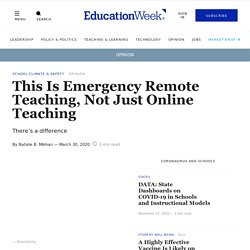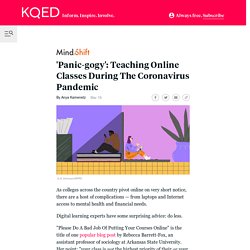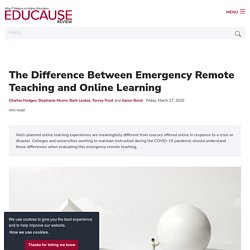

This Is Emergency Remote Teaching, Not Just Online Teaching (Opinion) I have taught online for nearly 20 years.

As an online professor at George Washington University, my courses continued through the 9/11 terrorist attacks, beltway snipers, Hurricane Isabel, the H1N1 virus, and “Snowmaggedon.” Even when I lost power and was stranded in my home, I charged my phone in my car and provided updates on our learning-management system from my smartphone. During these emergencies, however, the content was already developed and lectures scheduled to launch for the entire semester.
Clearly, disruption of our daily lives is not unusual, and preparedness is important, but what we are all experiencing because of COVID-19 is unprecedented. These are not normal teaching and learning conditions. It takes a lot of time and effort to design and develop effective, engaging online education. Well-designed online education can be just as effective as face-to-face instruction. On top of that, we are all living through a pandemic with a great deal of uncertainty. 1. 2. 3. 4. 5. Handout EmergencyRemoteLearning. The Differences Between Online Learning vs. Emergency Remote Teaching. There is a difference, Brown says, between true online education and the sudden, stopgap shift in which higher education institutions are currently engaged.

What’s occurring at present, he explains, is a rush job — an effort to mitigate the losses students and universities might experience were they forced to completely abandon a semester’s worth of work. “Researchers in educational technology, specifically in the subdiscipline of online and distance learning, have carefully defined terms over the years to distinguish between the highly variable design solutions that have been developed and implemented: distance learning, distributed learning, blended learning, online learning, mobile learning, and others,” notes the EDUCAUSE report.
“Yet an understanding of the important differences has mostly not diffused beyond the insular world of educational technology and instructional design researchers and professionals.” MORE ON EDTECH: Here's the Best Zoom Remote Learning Tech Tips. Youtube. Opportunities and Challenges in Emergency Situations. Emergency Remote Education Amid COVID 19 Pandemic. Leadership for Remote Learning Book. Youtube. Youtube. Youtube. 'Panic-gogy': Teaching Online Classes During The Coronavirus Pandemic.
Some colleges like Duke, Smith, MIT, Georgetown and Grinnell are starting to offer students the option of taking their Spring courses pass/fail given the circumstances.

In a time of virtual reality classrooms and AI-enabled automated tutoring programs, why are the experts in digital teaching calling for professors to simplify? "Everyone's freaked out," says Sean Michael Morris. He's in the School of Education and Human Development at the University of Colorado, Denver and the director of Digital Pedagogy Lab, an organization focused on digital learning, technology and social justice. Sean Michael Morris says that in this unprecedented time, "Recognizing that we're also human, we also have to figure this out together is incredibly important. The idea of being able to just port what you're doing in a classroom into an online environment has its own problems. Morris and other colleagues have a tongue-in-cheek name for what they're doing right now: "Panic-gogy" (for panic + pedagogy). Teaching during a pandemic: Resilience.
Youtube. SR Report Student and Faculty Experiences with Emergency Remote Learning 102220. The Difference Between Emergency Remote Teaching and Online Learning. Well-planned online learning experiences are meaningfully different from courses offered online in response to a crisis or disaster.

Colleges and universities working to maintain instruction during the COVID-19 pandemic should understand those differences when evaluating this emergency remote teaching. Due to the threat of COVID-19, colleges and universities are facing decisions about how to continue teaching and learning while keeping their faculty, staff, and students safe from a public health emergency that is moving fast and not well understood. Many institutions have opted to cancel all face-to-face classes, including labs and other learning experiences, and have mandated that faculty move their courses online to help prevent the spread of the virus that causes COVID-19.
The list of institutions of higher education making this decision has been growing each day. The temptation to compare online learning to face-to-face instruction in these circumstances will be great. Table 1. M.